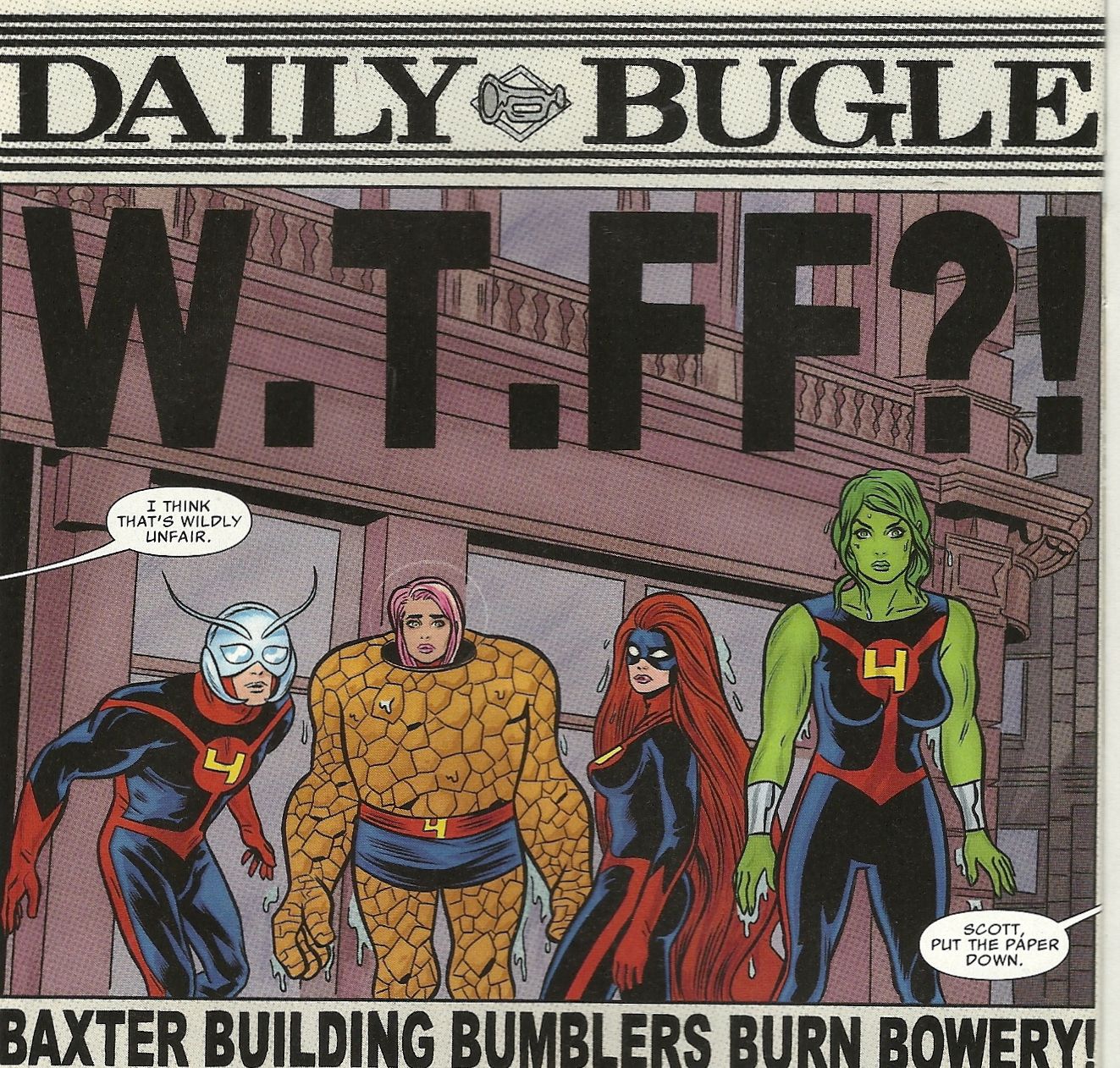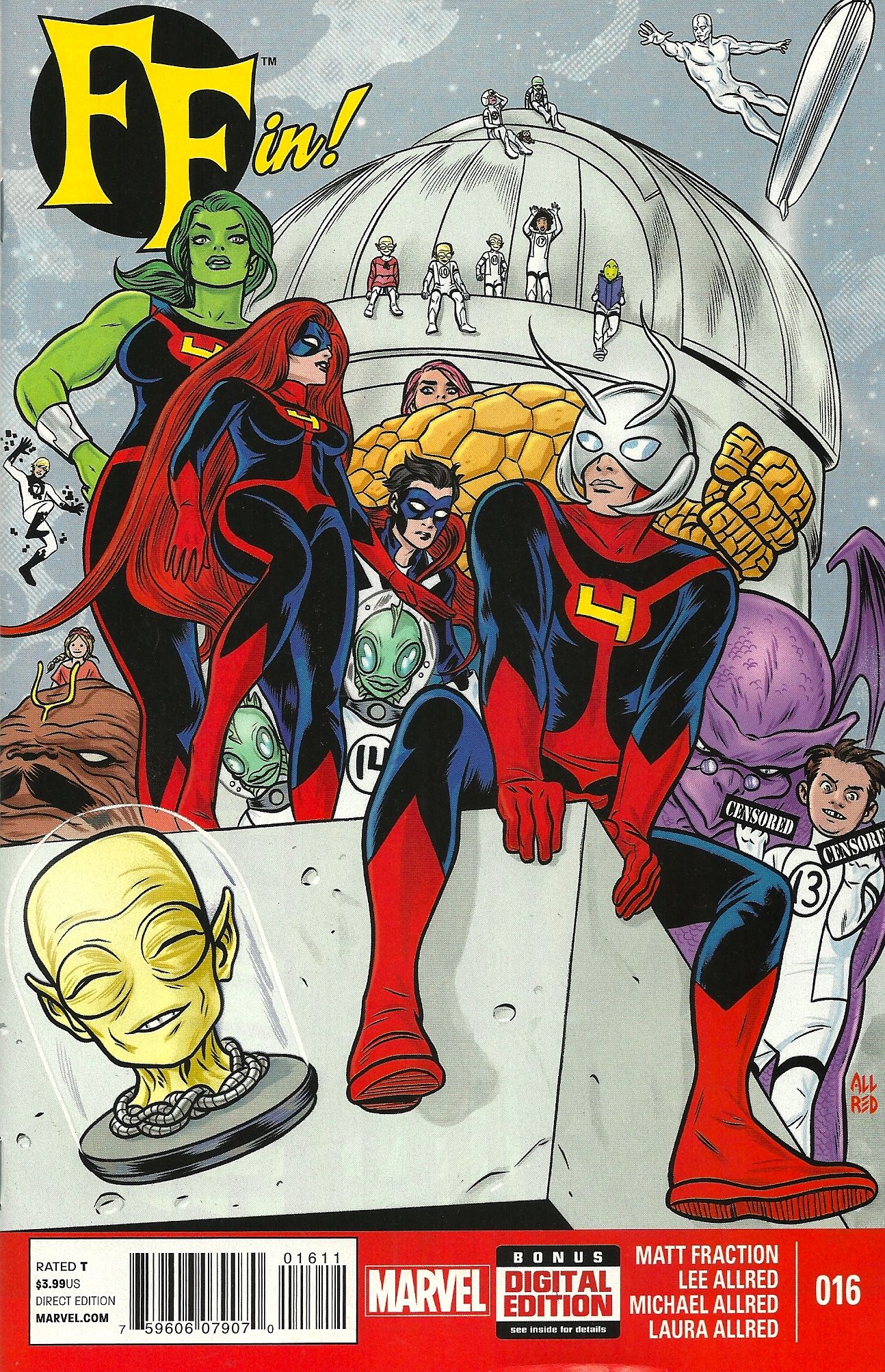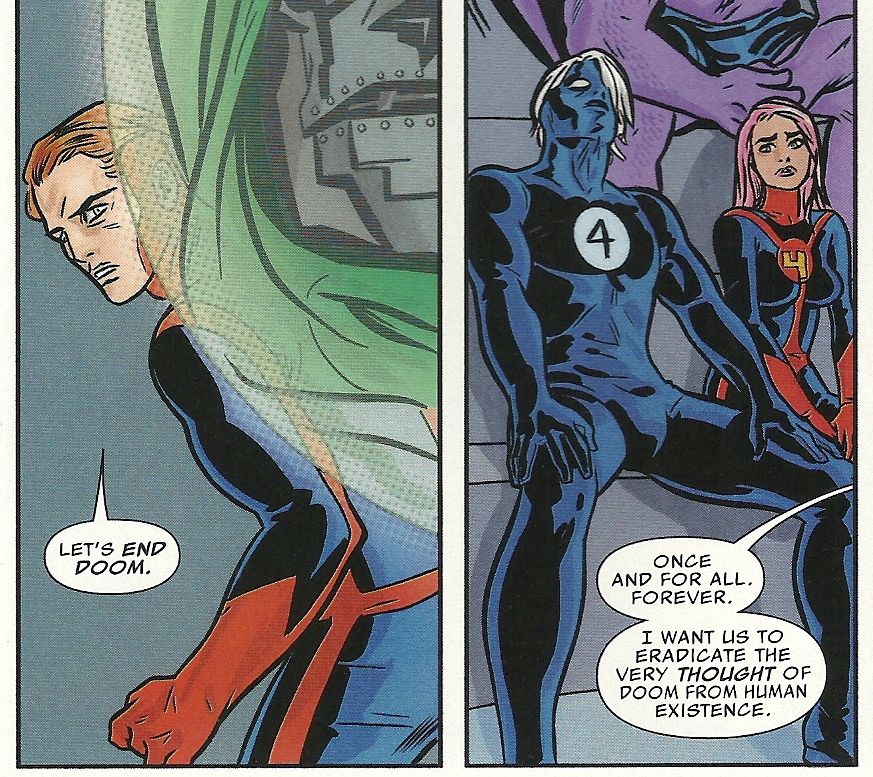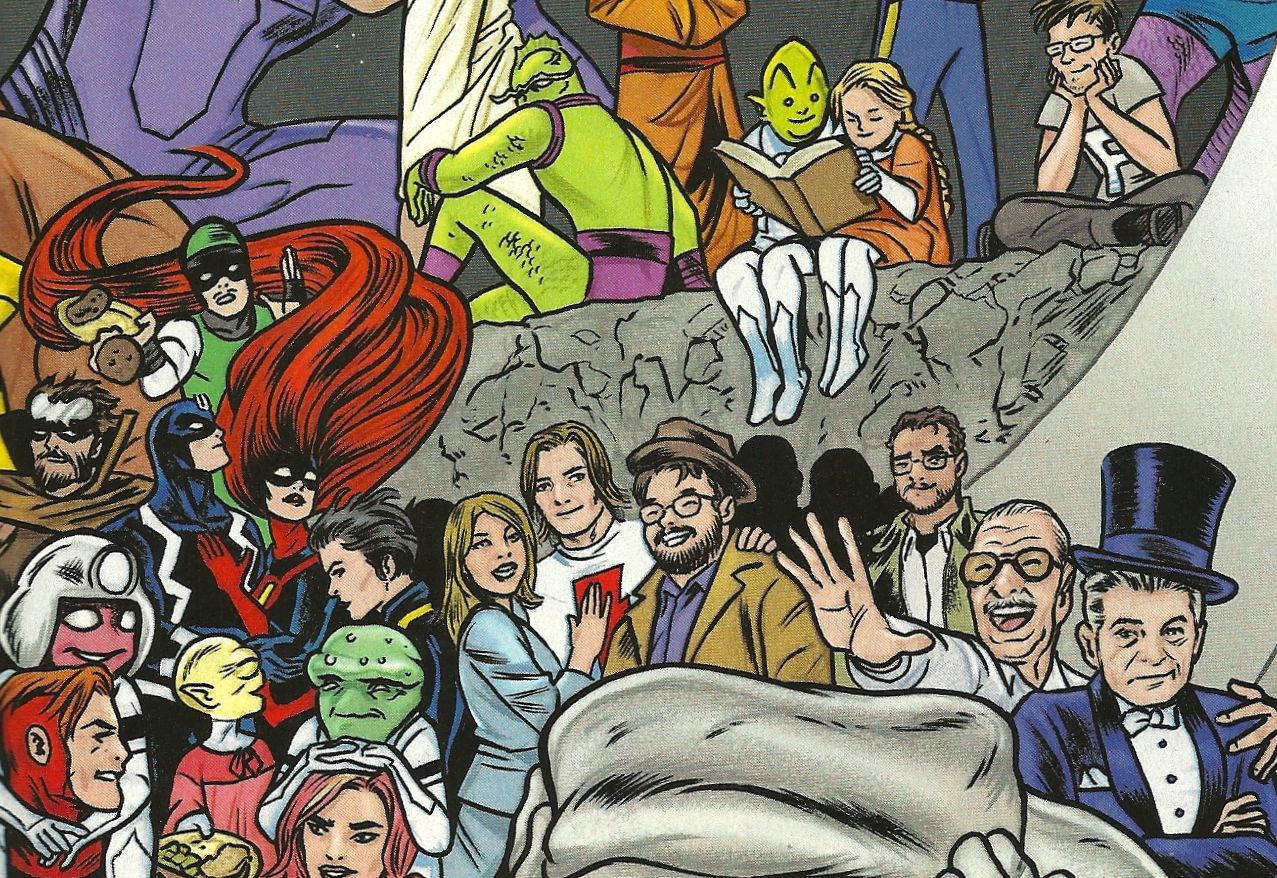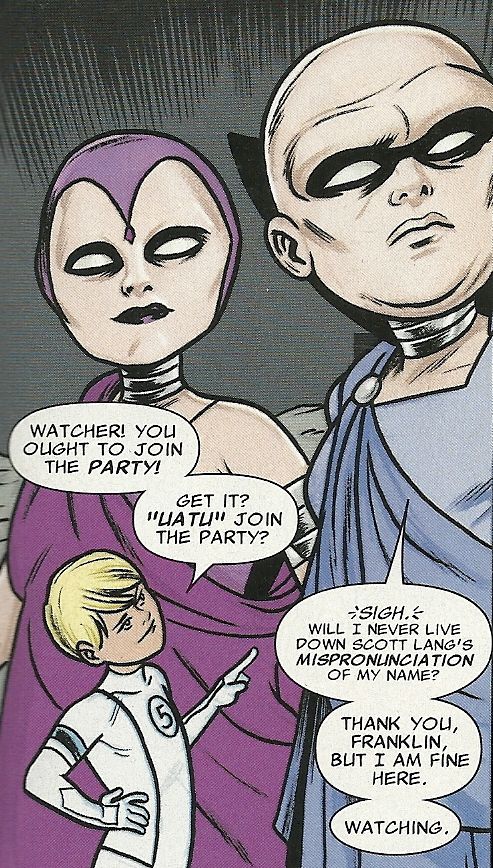Sixteen months after Marvel NOW! began, bringing with it new creative teams, new directions, new reboots of recently rebooted titles and new titles, the publisher is launching a new initiative. Marvel NOW! has become Marvel then, and the new NOW! is the All-New Marvel NOW!, which brings with it new creative teams, new directions, new reboots of recently rebooted titles, new titles and so on.
Not all of the NOW! titles are making the transition into the All-New NOW!, of course, and many of those that aren't are instead concluding (rather than being canceled), apparently having been designed from the start to only last a certain length of time, and these conclusions are taking big, pulpy chunks out of my pull-list.
This week Marvel shipped the last issue of my favorite NOW book: FF. Originally written by Matt Fraction, drawn by Mike Allred, colored by Laura Allred and, toward the end of its 15-issue run, scripted by Lee Allred from Fraction's plotting, it might not have been the best title Marvel is publishing (that's probably still Hawkeye), but it was certainly the most fun for the entire length of its short, bright life.
Fraction followed Jonathan Hickman on Fantastic Four, and thus inherited the new, Hickman-created two-book status quo: Fantastic Four, featuring the adventures of the original Marvel superhero team, and FF, devoted to the Future Foundation school for young geniuses that Reed Richards established. Under Fraction, Richards took his team and his two biological children on a trip through time and space, seeking a cure for what appeared to be a chronic condition that baffled even him, in the pages of Fantastic Four, drawn in a more modern Marvel style by Mark Bagley.
And in FF, the Four recruited their own replacements for a temporary, stand-in superhero team/faculty -- Ant-Man Scott Lang, She-Hulk, Medusa and Johnny Storm's pop -star girlfriend Darla Deering — to run the school and care for the kids in their stead. (And it was awesome.)
The two titles intersected in sometimes-unexpected ways — the F4 traveled back in time and met an alien posing as Julius Caesar, for example, and then, in the present, Caesar remembers the solid the original team did him, and he reaches out to the Future Foundation to help them — and necessarily had to be rather tightly plotted, beginning and ending simultaneously.
Fantastic Four was a solid, competently created book, but also a rather rote one, with Fraction seemingly writing what he thought a Fantastic Four book should be like, and Bagley drawing as he usually draws, but with nothing really passionate occurring. FF, on the other hand, featured the bright, clean, crisp, flat, decidedly old-school-looking art of Mike Allred, who draws some of the best versions of many Marvel characters since their creator Jack Kirby, in large part because he learned from and is trying to imitate Kirby's designs.
The last time Marvel employed Allred's talents at great length, it was during their millennial X-Men line shake-up, in which Allred was paired with writer Peter Milligan on X-Force, a deliberately subversive X-Men comic (and one that eventually changed its name to X-Statix, having thoroughly irritated plenty of X-fans by then).
In FF, his art's application was more celebratory than subversive, and Fraction seemed to be going out of his way to give his collaborator the opportunity to draw whatever the hell he wanted, not just the core cast of heroes (and the new costumes Allred designed for them), but all the Fantastic Four trappings that could be squeezed in: giant Kirby monsters, Mole Man, Wyatt Wingfoot, Inhumans galore, The Impossible Man (and his Impossible son Adolph), Blastaar, The Wizard, Annihilus and so on. Allred draws himself, Matt Fraction and Tom Brevoort and a tiger in the 10th issue, mainly for a series of jokes but, just as likely, because he really wanted to draw a tiger (and the man draws an awesome tiger). In this final issue, Silver Surfer drops by for no real reason, other than to perhaps let readers know Allred draws a mean Silver Surfer, as he'll get the chance to do on a monthly basis when he and writer Dan Slott launch an All-New Marvel NOW! Surfer title.
In places, the book read an awful lot like a Fantastic Four version of Jason Aaron's Wolverine and The X-Men, with the zany school full of fantastic super-kids , and yet balanced all of its humor with some pretty stark drama, most of which came from interpersonal conflicts. In that respect, FF was also a bit like Fraction's Hawkeye: It was a funny book that was being told straight.
Looking back from the ending, Fraction's plotting is even more remarkable. The third issue ends with Lang declaring his intention to eliminate Dr. Doom once and for all, and the 16th issue features Lang vs. Doom in a climactic battle that does just that. Various threads and subplots ran throughout the series, but consistent through them all was that Ant-Man wanted to take on and utterly defeat and humiliate Doom in a way Reed Richards never would and, in fact, never could -- and that's eventually just what happens (the battle eventually takes about two issues of planning, and two issues of execution).
Also remarkable is that the book told one big, 16-issue story, with no real starting and stopping. It wasn't exactly written for the trade, but rather as a whole. So too was Young Avengers, another of the better-looking, better-written NOW! books, which makes me wonder to what extent Marvel had its NOW! launches plotted as "seasons" of 16 issues or so that, if popular, could then be rebooted to follow new, similarly sized story arcs (a la Wolverine or the Hulk comic, which are getting new #1s and slightly different directions, but keeping their creative teams), or simply end as if they were only meant to last so long. Certainly in neither FF nor Young Avengers are there any loose ends hinting at unfinished business on the part of any of the creators.
After the 20-page climax of the series, the 16th and final issue ends with a 10-page story co-written by Lee Allred and Karl Kesel (who took over scripting for Fraction on Fantastic Four) and penciled by Joe Quinones (but inked by Mike Allred and colored by Laura Allred, so that it looks about as Allred-esqe as possible without Mike Allred penciling himself). That features the Fantastic Four joining the Future Foundation and their many allies on the moon for a celebratory cookout that serves as an epilogue to the 15 issues before it and offers possibilities for the future, up to and including the resurrection of Cassandra "Stature" Lang, Ant-Man's deceased daughter ("We could always dig up Cassie and check," Bentley-23, the clone of supervillain genius The Wizard, says when several of the little geniuses have a realization regarding Pym particles).
And it ends with a neat, two-page spread of a group photo, featuring all of the heroes and supporting characters to have appeared throughout the series, right down to Willie Lumpkin, Cargo Manshark, Tom Brevoort and the Allreds. Even Stan Lee and Jack Kirby, the latter looking a little irritated to be in the presence of his Fantastic Four co-creator and dressed in a top hat and tux, as if he were on his way to Reed and Sue's wedding.
FF was a great book, and, if you haven't read it yet, Uatu.
Ha ha! Uatu!

